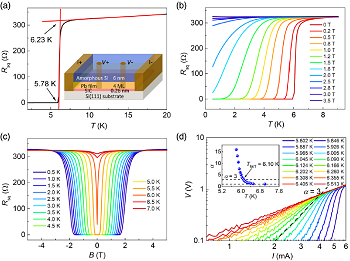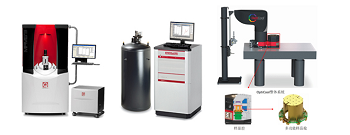Guide
In recent years, the concept of quantum materials has gradually entered everyone's field of vision. As the name implies, quantum materials are materials with strange physical properties due to the quantum properties of their own electrons. From copper oxide superconductors to iron-based superconductors, from graphene to topological insulators, more and more new materials cannot be accurately defined by the original spintronic materials and strong correlation systems, and the concept of quantum materials is essentially described Characteristics of such materials.
Throughout the decades of development of materials science, from the birth of the first superconducting quantum interferometer (SQUID) based on quantum materials in 1984 to the current artificial design and preparation of quantum materials, tools made of quantum materials are constantly promoting new types Research and development of quantum materials. Quantum Design is the witness and creator of this historical development from the original SQUID to the now complete "ecosphere" in the field of measurement. â€
text
Today we introduce the latest research progress of the research group of Professor Wang Jian (Quantum Design user) of Peking University on the artificial design of two-dimensional superconducting materials. In April 2018, Physical Review X reported the latest published research result of "Interface-Induced Zeeman-Protected Superconductivity in Ultrathin Crystalline Lead Films" by Peking University Professor Wang Jian's research group.
As we all know, in superconducting materials, electrons do not exist alone but in the form of "Cooper pairs". Applying an external magnetic field to the superconducting material will destroy the "Cooper pair" and thereby destroy the superconducting properties of the material. In ultra-thin two-dimensional superconducting materials, the in-plane limit magnetic field Bc is usually determined by the Pauli limit Bp, but recent studies have found that some special mechanisms can prevent the "Cooper pair" from being destroyed, so that Bc can exceed the Bp limit. For example, in a superconductor in a spin triplet state, the "Cooper pair" consists of pairs of electrons that are parallel to the spin, so the limit field can exceed the Pauli limit. In the disordered two-dimensional superconducting thin film, the Pauli limit corresponding to the traditional "Cooper pair" is replaced by spin-orbit scattering, which will destroy the spin orientation and weaken the spin paramagnetism. In addition, the internal spin-orbit interaction (SOI) also increases Bc. The Rashba-type SOI caused by the out-of-plane symmetry breaking can generate spin polarization to raise the limit field in the plane, but the upper limit of the in-plane limit magnetic field Bc is √2Bp. In high-quality two-dimensional superconducting materials with in-plane symmetry breaking, such as single-layer NbSe2 and MoS2, the phenomenon of Bc far exceeding the Pauli limit is also observed, which we call the Ising superconducting property. The spin polarization generated outside the plane due to the in-plane symmetrical breakage is called Zeeman-type SOI. The in-plane limit field Bc of such a two-dimensional superconducting material can far exceed the upper limit of the Pauli. However, most two-dimensional superconducting materials are plane symmetrical and cannot produce Zeeman-type SOI.

Figure 1 Measurement of the superconducting properties of materials under different magnetic fields and temperatures in the article
In order to study Zeeman-protect Superconductivity more deeply, Professor Wang Jian's group successfully prepared ultra-thin Pb film with in-plane band symmetry breakage on the surface of Si (111) through precise control. The limit magnetic field Bc in the plane of the Pb film is as high as 35.5T (the maximum measurement magnetic field), far exceeding the Pauli limit Bp = 14.7T, and the author explains the mechanism of the ultra-high Bc in the new film from theoretical calculations. The discovery of ultra-high Bc materials is of great significance for the study of superconducting mechanism and the application of superconducting materials, and also promotes the use of superconducting materials in strong magnetic fields and various extreme environments. This result also indicates that people are expected to discover new unconventional superconducting characteristics through interfacial modulation in two-dimensional superconducting systems.

Figure 2 The measurement of the limit field of 4, 5, and 6 Pb films at different temperatures in the article.
For more details, please refer to the original literature (DOI: 10.1103 / PhysRevX.8.021002)
In this study, the author used Quantum Design's comprehensive physical property measurement system PPMS and magnetic measurement system MPMS to make precise measurements on the electrical properties and magnetic properties of the material's magnetic field. The high-quality measurement data is also used for theoretical calculation and experimental comparison Provided important help. As the top equipment manufacturer of comprehensive physical properties and magnetic measurement, Quantum Design has witnessed the rapid development of China in the field of quantum materials. In the course of more than 30 years of development, Quantum Design, from the initial SQUID to the current MPMS3 and PPMS, has helped more and more researchers to use Quantum Design's high-quality equipment to achieve important scientific results.
Quantum Design also continuously introduces new equipment and functions according to user needs. At present, PPMS has become the most comprehensive measurement system including functions of force, heat, light, electricity, extremely low temperature, and microscopy. Quantum Design recently launched OptiCool, an ultra-precision fully open strong magnetic field low temperature optics research platform, which is a system specifically designed for low temperature strong magnetic field optics experiments. Combined with the existing MPMS and PPMS, Quantum Design has now formed a complete measurement "ecosphere", becoming the most complete measurement system in the field of quantum materials research. From quantum design to design quantum, Quantum Design advances with the times.

Figure 3 Quantum Design company equipment: MPMS3, PPMS and OptiCool
Here, Quantum Design once again congratulates Professor Wang Jian's research group on the important achievements, and also wishes the Quantum Design users a smooth scientific research!
Adhering to the principle of quality first and an excellent reputation, we provide customers with excellent Customer Service & quality of our goods along with competitively priced products. We believe there is no [best," only [better" with the spirit of constant challenge we are committed to the constant improvement of our designs and manufacturing standards and our customers complete satisfaction
Plastic Daily Use Items,Plastic Items Used In Daily Life,Disposable Plastic Containers,Plastic To Go Containers
Ningbo Meidai Import & Export Co.,Ltd , https://www.ningbomeidai.com